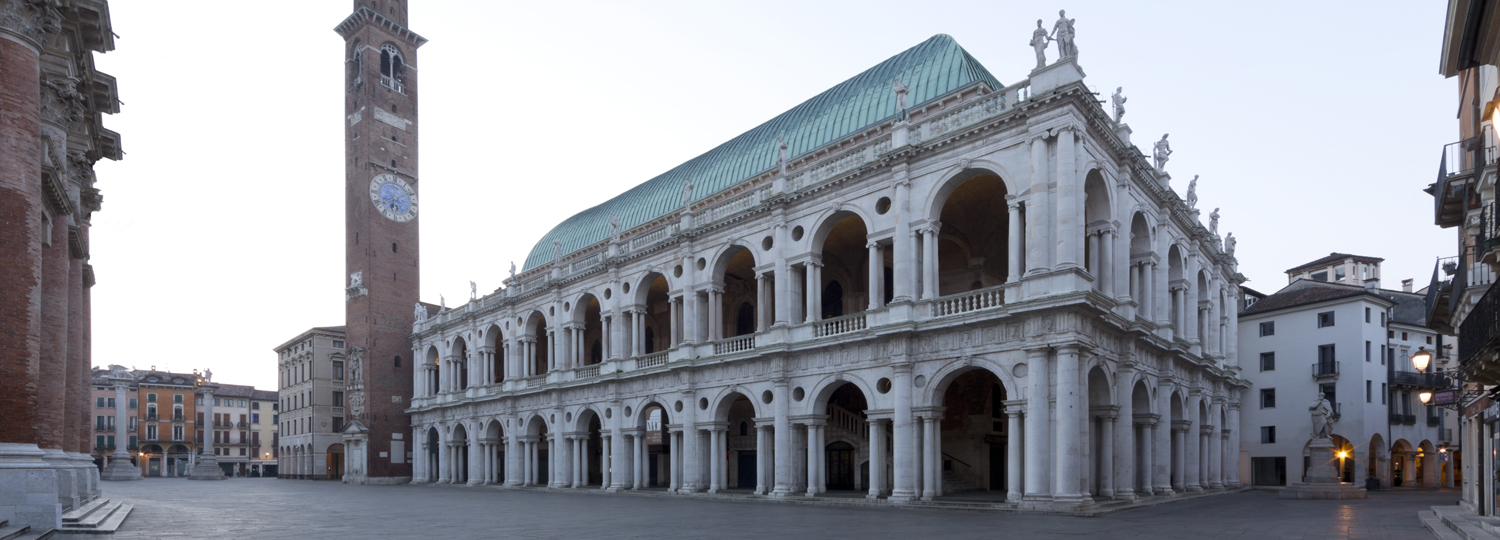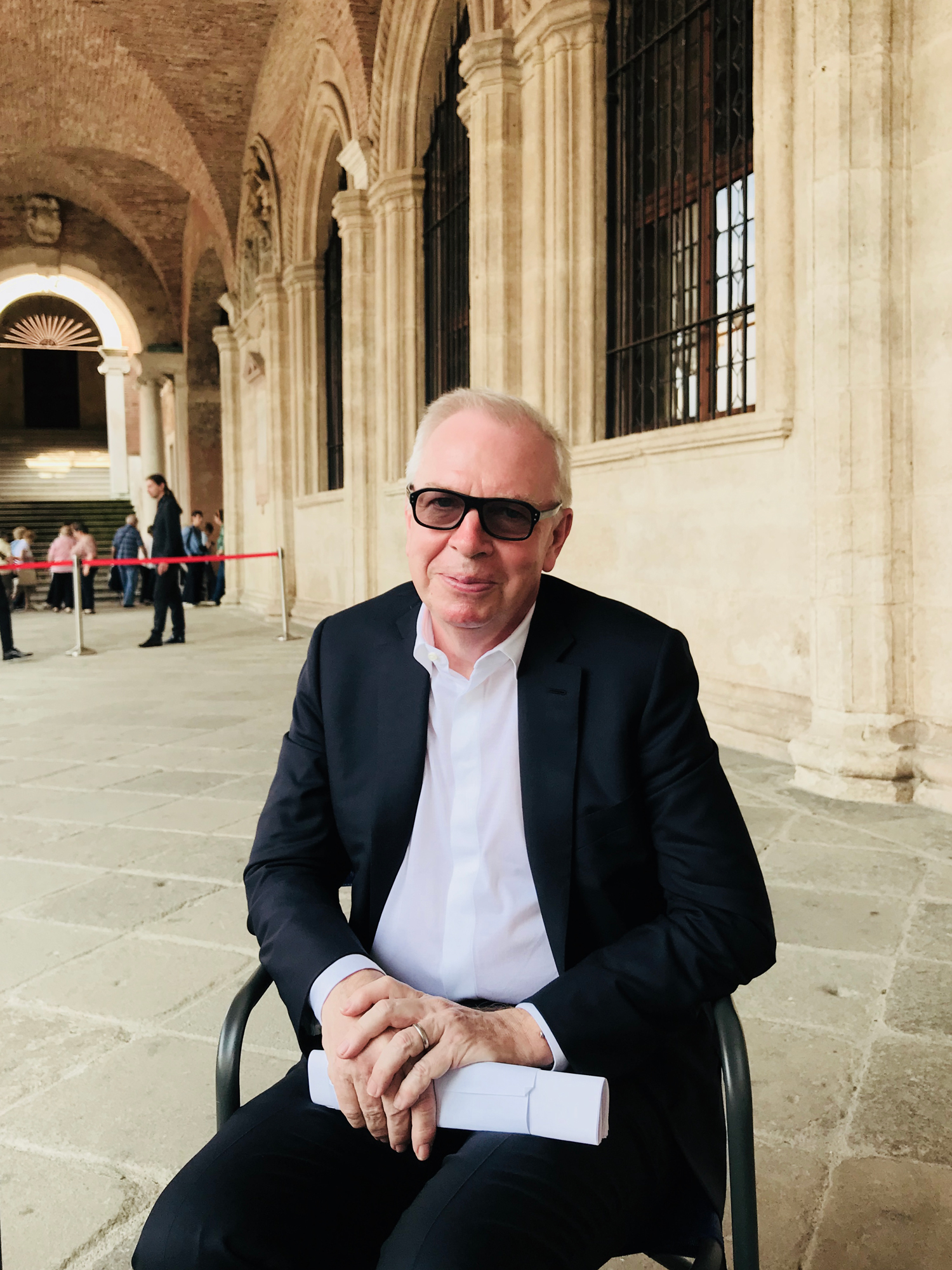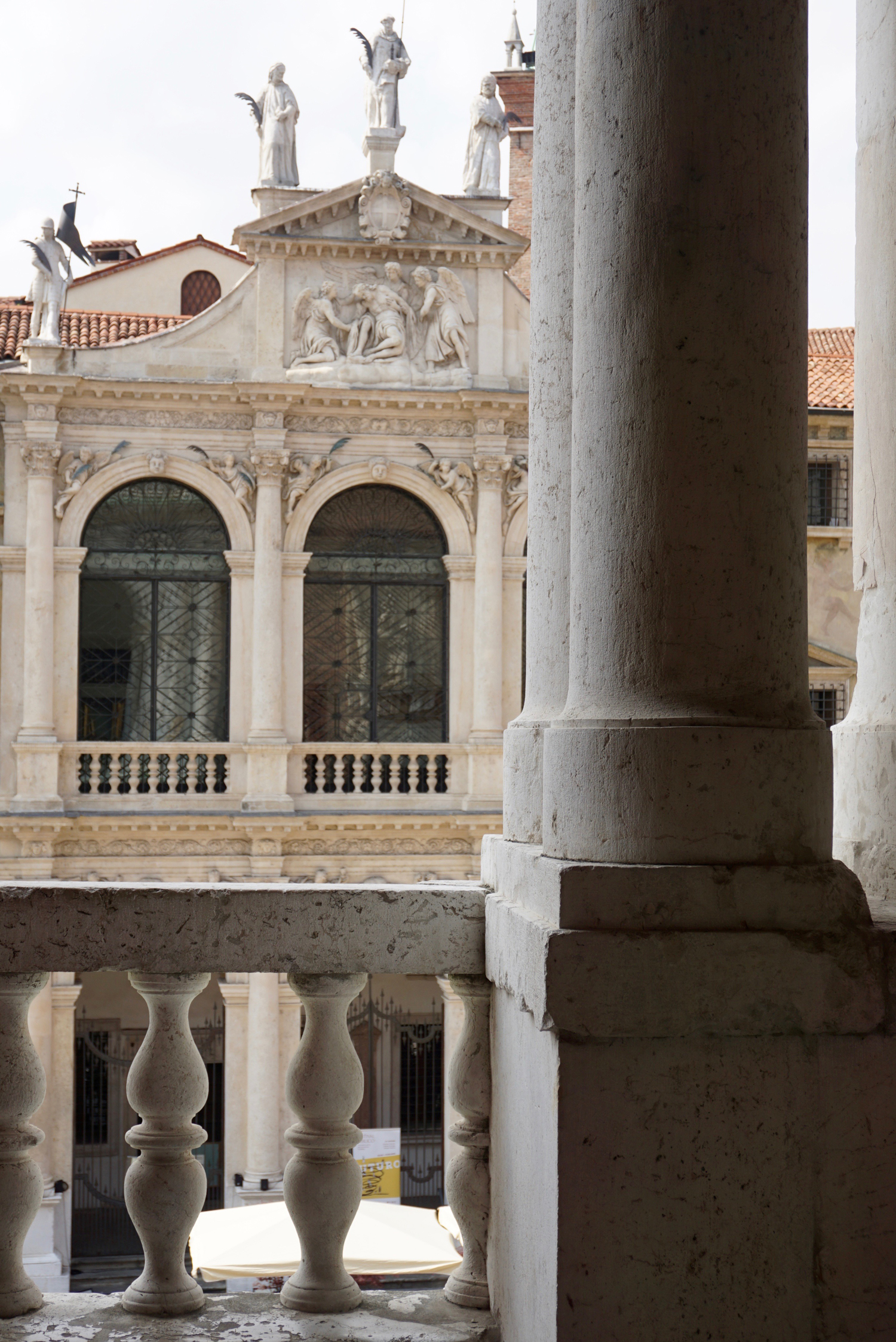David Chipperfield on the legitimacy of architecture

Foto: Simon Menges
Interview on site in Vicenza: David Chipperfield explains the challenges of architecture, the differences between London and Berlin and why he is considering himself a dinosaur.
You mentioned in your lecture that there should be a new definition of the profession of an architect today. What do you mean exactly by this?
David Chipperfield: Sitting here in the Basilica Palladiana, of course we would all like to have a similar legitimacy for our projects: to be able to design buildings which change and contribute in such a substantial way to the character of the city. But we cannot. At least, it is very unusual to find opportunities where we can. Despite this, we have found it difficult to let go of this role of the architect as a sort of master, and I think that is difficult for us to adjust to the architect as a facilitator and someone more flexible. We have to find a way by which the loss of power turns to flexibility and not just to weakness. If I compare our London and our Berlin offices: the London office works in a consumer and market-driven atmosphere, so they are very flexible. In Germany, architecture culture still comes from a public system. The mentality is that the architect should be commissioned in a clear way for the project – a condition to plan properly. There is a clearer idea of the protection of the profession, though this is gradually softening as we try to find more work in the market. In London, it is the opposite, we architects are more flexible by nature. A client in London might ask “Would you, or could you look at two more options? We need to see them by Monday.” In Berlin, you would not accept such a request; you would set up agreements, review resourcing and a realistic schedule. In London, however, we are more accepting of such demands. On one hand, I would say this flexibility means that the architects lose a bit of their integrity, the protection they should have and deserve. On the other hand, we are becoming less useful to the type of client that is coming our way.
Our experience at Detail is that more and more architects are not aware of the construction details of their buildings. So in order to find out the details, we have collaborate with facade planers, contractors and many others.
DC: We are old-fashioned in this. We still have a very strong control of the detail.
It is also a question of quality in the end.
DC: I know, but it is quite difficult to sell it. And it is not a very easy marketing strategy too. Either you are slow, expensive and good, or cheap, fast and less good.
In the exhibition in Vicenza, there are two books with construction details from the Neue Nationalgalerie in Berlin. One shows the original drawings from Mies van der Rohe and the other one those by your office, which is in charge of the repair of the iconic building. It’s quite impressive – there is a solution for every original detail.
DC: I know, it is like archaeology.
The building of the Basilica Palladiana was once also a question of repair – Palladio had to find a way how to deal with a previous structure. Architectural expression is not really the starting point for this kind of design.
DC: When we came to Vicenza, I asked Giuseppe Zampieri, who is from Vicenza and the Director of our Milan office, if he thought the Basilica Palladiana was shocking to people at the time of its creation. How would people have reacted? However, on second thought, the Basilica Palladiana has an architectural language that is familiar, an extension of a previous language. So the architectural gestures were more easily understandable. And I think in that sense, there is a balance between the invention of the genius individual architect and the societal gesture. For the opening event of the exhibition in May, we had over 300 people sitting here in the arcades of the Basilica and I had to admit to them “I am sorry, I cannot design anything better than this.” There is nothing stronger than seeing people using an architectural space like this, as a place to meet and for a common purpose. That is exactly the quality of space that we are looking for, and it has been extraordinary for centuries.
The last Venice Architecture Biennale put a focus on social issues and processes in architecture. This year’s edition on “Freespace” returns to the roots of architecture, negotiating its basic ingredients. Is this purpose similar to your “Common ground” concept for the Biennale in 2012?
DC: I think you are right, and the curators told me that my “Common Ground” theme was in some ways a basis for their idea. I think they gave a little bit more license to architects than I did at the time. I gave architects a hard time, I told them that I did not really want to see their architecture in the exhibition unless they can tell me what is behind it. This often involved several conversations, until we found common ground between us.
This year’s concept is very broad – “freespace” is defined literally as a space, but also meant as a metaphor. As I understand it, it is ultimately about an architectural quality that must be visible or usable.
DC: Yes, and I think the balance between social presence and physical beauty returned a bit more to physical beauty and away from the social.
Some architects from the younger generation are disappointed by this year’s Architecture Biennale. They see the social impact of architecture as being treated as a short-term aspect instead of being a substantial movement. What do you think about this position?
DC: I think the next generation has to define their own role as architects. I am myself a dinosaur, I represent the old idea of architects, building monumental buildings in an old-fashioned way, holding on to quality. I am more in a line to Palladio, in some sense. But I also think the non-profit project we have in Galicia, for example, which explores new perspectives of the identity of a whole region, also shows a new way of architecture, because we do not touch any building. In the end, if we work successfully for other projects, we will have more influence and we can do more good in Galicia with Fundación RIA than we can with a single building elsewhere.
You mentioned in your lecture that there should be a new definition of the profession of an architect today. What do you mean exactly by this?
David Chipperfield: Sitting here in the Basilica Palladiana, of course we would all like to have a similar legitimacy for our projects: to be able to design buildings which change and contribute in such a substantial way to the character of the city. But we cannot. At least, it is very unusual to find opportunities where we can. Despite this, we have found it difficult to let go of this role of the architect as a sort of master, and I think that is difficult for us to adjust to the architect as a facilitator and someone more flexible. We have to find a way by which the loss of power turns to flexibility and not just to weakness. If I compare our London and our Berlin offices: the London office works in a consumer and market-driven atmosphere, so they are very flexible. In Germany, architecture culture still comes from a public system. The mentality is that the architect should be commissioned in a clear way for the project – a condition to plan properly. There is a clearer idea of the protection of the profession, though this is gradually softening as we try to find more work in the market. In London, it is the opposite, we architects are more flexible by nature. A client in London might ask “Would you, or could you look at two more options? We need to see them by Monday.” In Berlin, you would not accept such a request; you would set up agreements, review resourcing and a realistic schedule. In London, however, we are more accepting of such demands. On one hand, I would say this flexibility means that the architects lose a bit of their integrity, the protection they should have and deserve. On the other hand, we are becoming less useful to the type of client that is coming our way.
Our experience at Detail is that more and more architects are not aware of the construction details of their buildings. So in order to find out the details, we have collaborate with facade planers, contractors and many others.
DC: We are old-fashioned in this. We still have a very strong control of the detail.
It is also a question of quality in the end.
DC: I know, but it is quite difficult to sell it. And it is not a very easy marketing strategy too. Either you are slow, expensive and good, or cheap, fast and less good.
In the exhibition in Vicenza, there are two books with construction details from the Neue Nationalgalerie in Berlin. One shows the original drawings from Mies van der Rohe and the other one those by your office, which is in charge of the repair of the iconic building. It’s quite impressive – there is a solution for every original detail.
DC: I know, it is like archaeology.
The building of the Basilica Palladiana was once also a question of repair – Palladio had to find a way how to deal with a previous structure. Architectural expression is not really the starting point for this kind of design.
DC: When we came to Vicenza, I asked Giuseppe Zampieri, who is from Vicenza and the Director of our Milan office, if he thought the Basilica Palladiana was shocking to people at the time of its creation. How would people have reacted? However, on second thought, the Basilica Palladiana has an architectural language that is familiar, an extension of a previous language. So the architectural gestures were more easily understandable. And I think in that sense, there is a balance between the invention of the genius individual architect and the societal gesture. For the opening event of the exhibition in May, we had over 300 people sitting here in the arcades of the Basilica and I had to admit to them “I am sorry, I cannot design anything better than this.” There is nothing stronger than seeing people using an architectural space like this, as a place to meet and for a common purpose. That is exactly the quality of space that we are looking for, and it has been extraordinary for centuries.
The last Venice Architecture Biennale put a focus on social issues and processes in architecture. This year’s edition on “Freespace” returns to the roots of architecture, negotiating its basic ingredients. Is this purpose similar to your “Common ground” concept for the Biennale in 2012?
DC: I think you are right, and the curators told me that my “Common Ground” theme was in some ways a basis for their idea. I think they gave a little bit more license to architects than I did at the time. I gave architects a hard time, I told them that I did not really want to see their architecture in the exhibition unless they can tell me what is behind it. This often involved several conversations, until we found common ground between us.
This year’s concept is very broad – “freespace” is defined literally as a space, but also meant as a metaphor. As I understand it, it is ultimately about an architectural quality that must be visible or usable.
DC: Yes, and I think the balance between social presence and physical beauty returned a bit more to physical beauty and away from the social.
Some architects from the younger generation are disappointed by this year’s Architecture Biennale. They see the social impact of architecture as being treated as a short-term aspect instead of being a substantial movement. What do you think about this position?
DC: I think the next generation has to define their own role as architects. I am myself a dinosaur, I represent the old idea of architects, building monumental buildings in an old-fashioned way, holding on to quality. I am more in a line to Palladio, in some sense. But I also think the non-profit project we have in Galicia, for example, which explores new perspectives of the identity of a whole region, also shows a new way of architecture, because we do not touch any building. In the end, if we work successfully for other projects, we will have more influence and we can do more good in Galicia with Fundación RIA than we can with a single building elsewhere.






